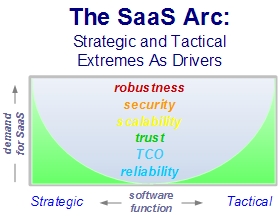Extremes will drive online enterprise software adoption

Too often cut off from direct accountability and saddled with a long backlog of user demands, IT departments frequently have little incentive or ability to be responsive to the business. And like personal computing did to the previous generation of computing, this will drive business units to solve their own problems using simple, inexpensive alternatives. Yes, folks, I'm talking about Software as a Service (SaaS).
I do expect more and more software, inside and outside the enterprise, will shift to SaaS faster than most of us think.From a ready list of sources, users, departments, and entire divisions can now just sign up for online application solutions that come with a virtually complete IT infrastructure including customer support, backup, 24/7 uptime, and low cost/maintenance. It's a compelling proposition that folks are getting increasingly familiar with and interested in.
While nuisances like bandwidth management, budgeting issues, and trust will continue to hamper adoption for many, the last few pieces that are really needed to drive SaaS into the enterprise have fallen in place: The Web 2.0 movement is giving a great many people comfort and experience with large-scale, collaborative online SaaS. And technologies like zero-footprint rich Ajax clients, a trend towards SaaS applications as easy-to-integrate with open platforms, and the sheer number of high-quality online business applications are making the choice easier and easier. Particularly when economies of scale of SaaS have the potential to dramatically drive down the overall cost of software.
Compelling offerings from Salesforce.com and 37signals in particular are making people take notice with head turning features and ease-of-use. And while exact adoption numbers for online business software is still not clear yet, last week's SaaS Summit in Napa Valley gives us some good indications that it's poised to take off this year like no other.
But there are also a few jokers in the SaaS deck. One is that outsourcing with SaaS will might well go strongly in two directions (in and out of the firewall.) Forward-thinking enterprises will look hard at turning their own strategic IT assets into hosted products, spurring SaaS interest and experience internally. The other is that net neutrality could likely interfere with the very service backbone that SaaS depends on, sow uncertainty, and slow adoption.

So for now, the SaaS question usually boils down to core decision points. Does SaaS offer enough reliability, security, scalability, and in the end, trust for companies to bet their businesses on? The answer for many right now will be no. And so early adoption will be left to extremely tactical and non-critical functions like corporate blogging and wikis.
But the surprise will be on the other side of the SaaS arc, and that is when companies take their high value, automated critical methods, business processes, and data sources and turned them - mostly amortized and paid for already - into profitable hosted for-fee services. This is where more and more smart enterprises will resell their existing business "components" as open, reusable services. As long they don't compromise their customer data or business strategies of course. Amazon and others have proven this is a workable and financially rewarding model though it has risks of its own, which I'll cover here soon.
The extremes will thus drive SaaS initially; business will seek to monetize their strategic IT assets while they begin to use SaaS for tactical uses initially. Middle-of-the-arc uses will happen of course, but they will be the minority.
SaaS is coming to your organization whether you want it to or not, though how fast and in exactly what clothes remains to be seen. Re-sale of trategic IT assets as services may very well become the wild card that drives SaaS awareness and interest from an unexpected angle. And while I am a bit concerned about net neutrality, it will only introduce a time delay. The time is right for SaaS and the pieces are in place on both the supply and demand side. I do expect more and more software, inside and outside the enterprise, will shift to SaaS faster than most of us think.